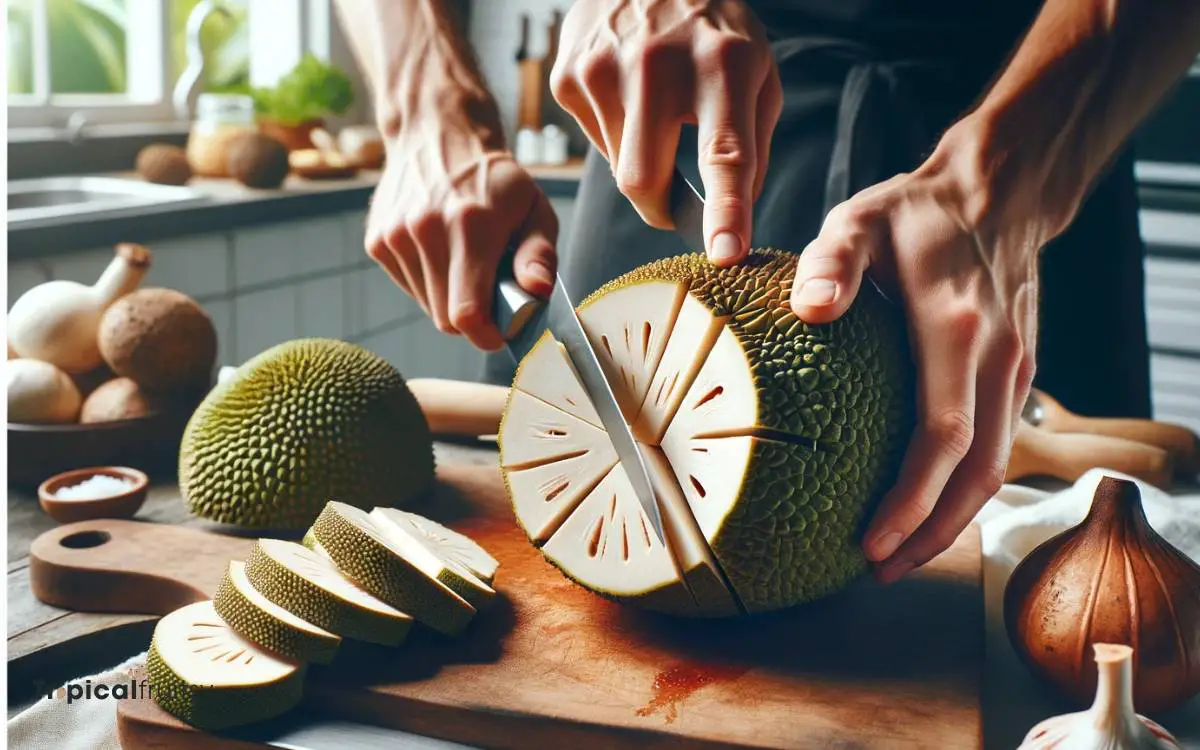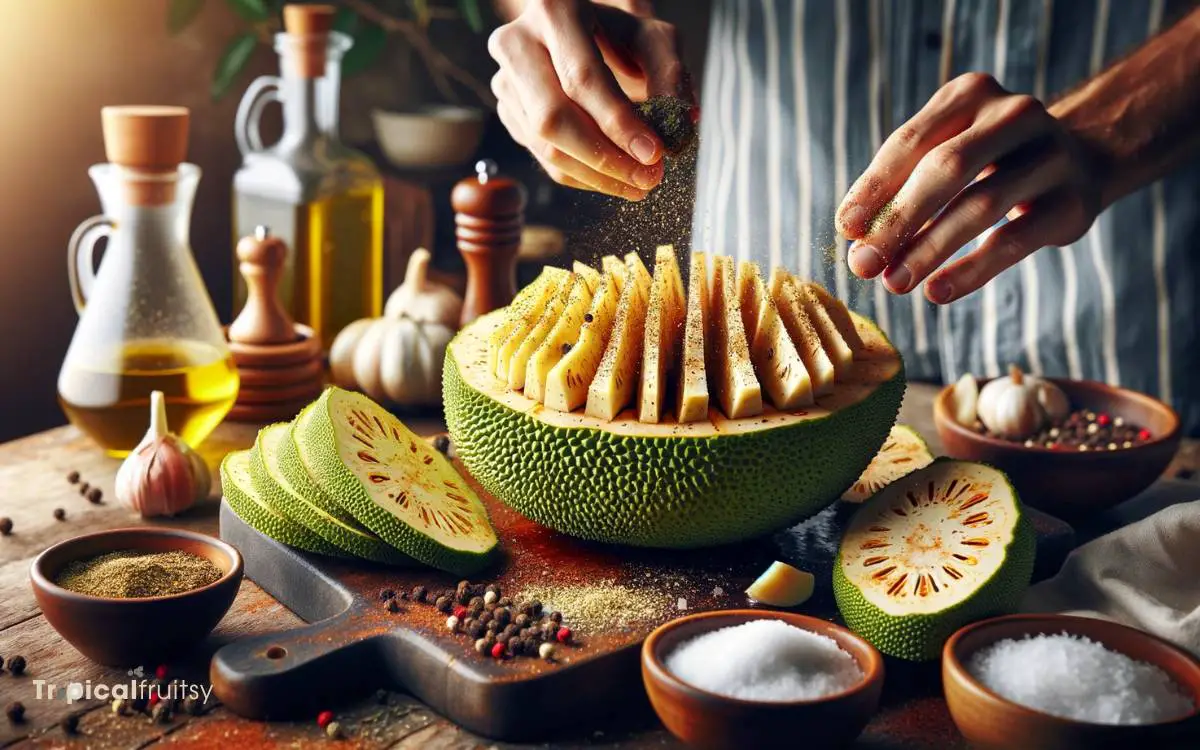How to Roast Breadfruit in the Oven? 6 Easy Steps!
Roasting breadfruit in your oven is a simple process that results in a delicious alternative to traditional roasted vegetables.
To ensure the perfect roast, start by selecting a ripe breadfruit that’s still firm to the touch. Wash the breadfruit thoroughly and make incisions to allow for even cooking.
Preheat your oven to a temperature of around 350°F (175°C). You can then season the breadfruit to your liking, with options ranging from a light brush of olive oil to a mix of savory herbs and spices.
Place the breadfruit in the oven and roast until it turns golden brown with a fluffy interior, which typically takes about one hour.
Knowing when the breadfruit is done is key—it should be soft inside and crisp outside. Roasting breadfruit is akin to preparing other starchy vegetables in the oven.
Here are some quick steps:
Roasted breadfruit is versatile and can be served as a side dish or incorporated into various recipes.
Discover the joy of oven-roasted breadfruit, a tasty and nutritious addition to any meal.

Key Takeaway
Step 1: Selecting the Perfect Breadfruit

Choosing the right breadfruit is essential for a successful roasting, with every mature, firm specimen promising a delightful culinary experience.
Begin by inspecting for ripeness; the ideal candidate exhibits a uniform green hue without excessive soft spots, indicating overripeness, or a predominance of brown areas, suggesting decay.
Gently press the surface; it should yield slightly under pressure, a testament to its readiness for roasting. Furthermore, the skin should be blemish-free and the fruit heavy for its size, hinting at a moisture-rich interior.
Ascertaining the absence of pest perforations is also crucial, as they compromise the flesh integrity.
Securing a prime breadfruit is paramount, setting the stage for an exquisite, roasted delicacy with a rich, creamy texture and nuanced flavor profile.
Step 2: Preparing Your Breadfruit

Prior to roasting, ensure that the breadfruit is at peak ripeness, characterized by a slight softness to the touch and a green-yellow skin.
Proceed by slicing the fruit into even sections, excising the core and any fibrous parts to facilitate even cooking.
Lastly, a liberal application of culinary oil, coupled with a judicious seasoning, will enhance the breadfruit’s natural flavors and ensure a crisp exterior upon roasting.
Selecting Ripe Breadfruit
To ensure optimal flavor and texture, one must carefully pick out a ripe breadfruit before proceeding with the roasting process.
Selecting a breadfruit at the correct stage of ripeness can be discerned through a combination of tactile, visual, and olfactory indicators:
- Examine the Skin: A ripe breadfruit has a green-yellow skin with a slight softness upon gentle pressure. The presence of brown patches is an indication of maturity.
- Assess the Texture: The fruit should yield slightly under pressure, similar to a ripe avocado. Overly soft or mushy spots may indicate over-ripeness or spoilage.
- Smell for Ripeness: A mature breadfruit emits a fragrant, sweet aroma. An absence of scent could imply immaturity, while an unpleasant odor suggests decay.
Employ these guidelines to select a breadfruit that will deliver the desired culinary results when roasted.
Cutting and Coring
How does one properly prepare a breadfruit for roasting by cutting and coring it? Begin by placing your breadfruit on a stable cutting surface.
With a sharp knife, slice off the stem and base to create flat surfaces, stabilizing the fruit. The next step is to make a deep vertical incision to divide the fruit into two equal halves. Once halved, remove the core and any visible seeds.
Here’s a quick guide to cutting and coring:
| Step | Action |
|---|---|
| Stabilize | Slice off stem and base |
| Halve | Make a deep vertical incision |
| Remove Core | Extract the spongy core and discard |
| De-seed (if needed) | Scoop out any seeds using a spoon or your hands |
With the fruit halved and cored, you now have a blank canvas for roasting. Next, let’s explore how to enhance the flavor with oil and seasoning.
Oil and Season
Once your breadfruit is halved and cored, it’s time to enhance its natural flavors with a generous application of oil and your choice of seasonings.
Properly seasoning your breadfruit is crucial for achieving a delectable roast. Start with a high-quality oil that has a high smoke point, such as extra virgin olive oil or avocado oil, to ensure even coating and to prevent burning.
Here is a straightforward guide to prepare your breadfruit for roasting:
- Brush the Breadfruit: Coat the flesh of the breadfruit evenly with oil, using a pastry brush to reach all the nooks and crannies.
- Season Generously: Apply a liberal amount of seasoning, incorporating a blend of herbs and spices like garlic powder, smoked paprika, and a pinch of sea salt to taste.
- Infuse Flavors: Allow the oiled and seasoned breadfruit to sit for a few minutes, enabling the flavors to penetrate deeply before roasting.
Step 3: Preheating the Oven

Prior to roasting, it is imperative to adequately preheat your oven to create the ideal thermal environment for the breadfruit.
Set the oven to 350 degrees Fahrenheit (175 degrees Celsius), which is the optimal temperature to ensure even cooking and a desirable texture.
Allow the oven to preheat for at least 15 minutes, ensuring it reaches a uniform temperature throughout.
Optimal Temperature Setting
Preheating the oven to 375 degrees Fahrenheit (190 degrees Celsius) is essential for achieving a perfectly roasted breadfruit.
This specific temperature is the culinary sweet spot that ensures the breadfruit cooks thoroughly without drying out, allowing for a desirable texture—crisp on the outside while remaining soft and succulent on the inside.
- Uniform Heat Distribution: At 375°F (190°C), the oven provides a consistent cooking environment, crucial for even roasting.
- Retention of Moisture: Lower temperatures may not adequately caramelize the sugars within the breadfruit, while higher settings may cause excessive moisture loss.
- Optimization of Cooking Time: This temperature balances efficiency with quality, typically requiring 60-90 minutes, depending on the size and ripeness of the breadfruit.
Preheat Duration Tips
To ensure optimal roasting conditions, allow at least 15 minutes for the oven to reach the recommended temperature of 375 degrees Fahrenheit before introducing the breadfruit.
This preheating period is crucial for stabilizing the oven’s internal atmosphere, which must be consistently heated to create the perfect roasting environment for the breadfruit.
Uneven temperatures can lead to suboptimal roasting, affecting the texture and flavor profile of the final dish.
Use an oven thermometer to verify accuracy, as built-in gauges can sometimes be imprecise. Once the oven is adequately preheated, the consistent radiant heat will facilitate even caramelization and a desirable crispness to the breadfruit’s exterior.
Now, with the oven preheated and ready, let’s turn our attention to properly seasoning your breadfruit for roasting.
Step 4: Preheating the OvenSeasoning Your Breadfruit

Seasoning plays a crucial role in enhancing the natural flavors of breadfruit when roasting it in the oven. The application of well-chosen spices and herbs can elevate this starchy staple into a culinary delight.
For optimal results, consider the following:
- Olive Oil: A generous brushing of extra-virgin olive oil not only prevents sticking but also serves as a medium to adhere seasonings to the breadfruit’s surface, adding a subtle richness to the dish.
- Herbal Aromatics: Freshly chopped herbs such as rosemary, thyme, or cilantro contribute layers of flavor, complementing the breadfruit’s inherent sweetness and nutty undertones.
- Sea Salt and Pepper: A judicious sprinkle of coarse sea salt and freshly ground black pepper before roasting will enhance the breadfruit’s flavor profile and accentuate its natural taste.
Use these guidelines to masterfully season your breadfruit for a truly savory experience.
Step 5: Roasting Time and Temperature

Typically, breadfruit is roasted at a temperature of 350°F (175°C) for one to one and a half hours, until its flesh is soft and golden brown.
This optimal temperature allows the breadfruit to cook through evenly, transforming its starchy content into a sweeter, more flavorful profile.
It is crucial to preheat your oven to the specified roasting temperature to ensure consistent cooking conditions.
During the roasting process, rotate the breadfruit periodically to promote uniform caramelization of the skin and prevent any area from overcooking.
The readiness of the breadfruit can be gauged by inserting a skewer or fork into its flesh; it should penetrate with minimal resistance, indicating a perfectly tender interior.
Adjustments in roasting duration may be necessary depending on the size and ripeness of the breadfruit.
Step 6: Checking for Doneness

Assessing the readiness of your roasted breadfruit involves checking for a tender interior and an evenly browned exterior.
To ensure culinary success, follow these detailed steps:
- Perform the Piercing Test: Use a skewer or a small knife and pierce the thickest part of the breadfruit. If it slides in easily without resistance, the starches have softened, indicating a perfectly tender interior.
- Visual Inspection: Examine the skin of the breadfruit; it should have a golden-brown hue and a slight crispness. Uniform coloration is a hallmark of well-roasted breadfruit.
- Aroma Cues: Be attentive to the fragrance emanating from your oven. A fully-roasted breadfruit emits a sweet, smoky scent, signaling that it may be ready for removal from the oven.
Serving and Storage Tips
Upon removing your breadfruit from the oven, allow it to cool for a few minutes before slicing to serve, and adhere to proper storage methods to maintain freshness.
To ensure optimal enjoyment, cut the breadfruit into even wedges or slices, depending on your presentation preference.
The succulent, roasted flesh pairs excellently with a bevy of accompaniments, from a drizzle of olive oil and a sprinkle of sea salt for a simple approach, to a robust chimichurri or a tangy balsamic reduction for a more complex flavor profile.
For storage, wrap any uneaten breadfruit tightly in cling film or transfer to an airtight container. Refrigerate promptly to retard spoilage and consume within two to three days. Reheat gently to preserve the texture and taste integrity.
Can I Use the Same Steps for Roasting Breadfruit in the Oven and on the Grill?
Yes, you can use the same steps for roasting breadfruit in the oven and on the grill. Whether you choose to roast your breadfruit on grill over an open flame or in the oven, the steps for preparing and cooking the fruit remain the same. Enjoy your delicious roasted breadfruit on grill!
How to Roast Breadfruit on Stove

Roasting breadfruit on a stove is a popular method in many tropical regions.
Here’s a step-by-step guide on how to do it:
Ingredients:
- 1 ripe breadfruit
Tools:
- Gas stove or electric stove with an open flame
- Long-handled fork or metal skewer
- Tongs
- Oven mitts or kitchen towels
- Cutting board
- Knife
Instructions:
Choose a Ripe Breadfruit:
- Select a ripe breadfruit. Ripe breadfruit is green and firm with some brown patches on the skin. It should yield slightly to pressure when you squeeze it.
Preheat the Stove Burner:
- Turn on your gas stove burner to medium-high heat. If you have an electric stove with an open flame option (like a coil burner), use that.
Prepare the Breadfruit:
- Place a cutting board on a stable surface. Using a knife, make a shallow, horizontal cut around the circumference of the breadfruit. Be careful not to cut too deep. This cut helps release steam during roasting.
Roast Over the Flame:
- Hold the breadfruit with a long-handled fork or metal skewer, keeping it securely above the flame.
- Rotate the breadfruit slowly and consistently to ensure even roasting. You’ll start to hear crackling and see the skin blacken and char.
Roast Until Done:
- Continue roasting the breadfruit for about 20-30 minutes, or until the skin is charred and the fruit inside is soft. You can check for doneness by piercing the breadfruit with a fork or skewer. It should go in easily.
Remove from Heat:
- Once the breadfruit is roasted to your satisfaction, turn off the stove burner.
- Use tongs to carefully remove the breadfruit from the heat source.
Cool and Peel:
- Allow the roasted breadfruit to cool for a few minutes until it’s safe to handle.
- Using oven mitts or kitchen towels to protect your hands, peel away the charred skin. The inner flesh should be soft and creamy, with a texture similar to mashed potatoes.
Serve and Enjoy:
- Slice or cut the roasted breadfruit into pieces or chunks.
- Serve it as a side dish, a starchy component of a meal, or in various culinary preparations, such as roasted breadfruit salad, breadfruit fries, or breadfruit mash.
Roasted breadfruit has a unique and nutty flavor, making it a delicious and versatile addition to your meals. Enjoy it on its own or as part of your favorite dishes.
Conclusion
The art of roasting breadfruit in the oven is a culinary journey that transforms a simple tropical staple into a delectable treat.
Mastery of this process entails selecting prime breadfruit, meticulous preparation, precise seasoning, and careful attention to roasting times and temperatures.
The result is a dish that, when served and stored with expertise, not only tantalizes the palate but also preserves the integrity of this versatile fruit for future enjoyment.






